These four eyewitness testimonies from the Hong Kong protests describe chaos and fear as civilians armed with only umbrellas are tear gassed by riot police. Xuanfung Lee reports.
More than a million protesters took to the streets in Hong Kong to protest against a new extradition bill (which is opposed by Amnesty International) and participate in a peaceful demonstration on June 9. Hundreds of thousands then gathered at the Legislative Council from June 11 to 13 to suspend the debate that would allow the enforcement of the extradition bill (find out more about the bill here).
The Hong Kong (HK) government authorised the attack of unarmed protestors, journalists and civilians. At least 72 people have been injured, with two seriously wounded. The HK government and the Hong Kong Police Force (HKPF) accused the protestors of carrying “lethal weapons” and labelled the protests “riots”. Protestors, however, have been seen armed with only umbrellas, helmets and clinical masks, while police officers have been photographed in full protective gear, using tear gas, pepper spray, bean bag rounds (also known as flexible baton rounds – a fabric “pillow” filled with lead shot fired from a shotgun) and rubber bullets. Following the violence, Britain has banned the sale of tear gas to Hong Kong. Many Hongkongers believe the police have abused their power and are calling for all officers who have used excessive force to be condemned and brought to justice.
Two million demonstrators took to the streets again the following Sunday (June 16), drawing international attention. And this week protesters held a six-hour rally outside Hong Kong’s police headquarters.
Two local journalists and two Hong Kong citizens who were involved in this month’s protests describe what they saw.

A protester stands with his arms in the air as the crowd defend themselves with clinical masks and umbrellas. By Choy Fuk Sang
Citizen A
On June 12, at about 3pm, I had just finished distributing resources such as medicine, first aid kits, bottles of water, helmets and masks somewhere near The Hong Kong Academy for Performing Arts (HKAPA) The atmosphere was peaceful at that time. About half an hour later I learned from the news that there was a confrontation happening outside the Legislative Council nearby. My friend and I were monitoring updates from the television and live broadcasts though the signal was not good.
A moment later, we saw smoke coming towards us from the Legislative Council down the road. People started to get nervous but the protest organiser, Civil Human Rights Front, repeatedly reassured the crowd that they had applied for a “letter of no objection” to ensure the protest was legal [the government made no comment or response to this application].
Not long after, the first tear gas grenade went off. I was on the frontline, somewhere towards the left. The gas did not affect me at first but then the cops started to fire more and more tear gas grenades and one landed pretty close to me. My friend grabbed my hand immediately and forced me to run. We ran as fast as we could until we reached an open area. We thought it was over and that the police wouldn’t drop more bombs.

A protester with only an umbrella, a clinical mask and goggles is engulfed by tear gas. By Choy Fuk Sang
But I told my friend, we should go anyway. Before I could finish my sentence, another tear gas grenade was hurled at the space where we were standing, leaving us no choice but to run forward, towards the Citic Tower.
The front was flooded with people. We heard people screaming, knocking and hammering at the front door. But the door was stuck. And so were we.
The police had been continuously bombing the area with tear gas and there was billowing smoke everywhere. My eyes couldn’t stop watering and I could barely see the road. I kept coughing. I couldn’t breathe, or speak. I felt like I was suffocating. All I knew was to run. But the Citic Tower remained closed for a long time.
When it finally opened, we ran into the building. It was cramped and the tear gas was irritating. I really believe it could have resulted in a stampede if people were not helping each other out, given the fact that everyone was rushing to the Tower. It was honestly like the scene in the movie Train to Busan, when passengers were running for their lives in the face of a bunch of zombies.
Everything including the escalators was out of order at the Citic Tower so I had to walk into the mist. The goggles didn’t help at all and my eyes kept watering as I crawled step-by-step out of the building towards the bridge.
I was naïve to think that we would be safe by then. The second I arrived at the bridge I heard someone yell: “Tear gas grenade! Another tear gas grenade!” The police had fired another grenade at the back of the crowd, forcing people to run. The atmosphere was terrifying because we were all just fleeing – we did not know what was happening except the smoke was around every corner and people kept coughing.
The people I was with were helping each other to rinse their eyes and their noses, passing the bottle of water to take turns.
What the police did was unforgivable. The protest organiser had applied for the “letter of no objection” and as citizens we have the right to freedom of assembly. We couldn’t believe the police treated us with such violence and brutality.

Protesters attempt to dodge tear gas. By Choy Fuk Sang
Journalist B
I stayed in Lung Wo Road near the Wan Chai Exhibition Centre the whole day. I saw protestors covering their faces with caps, helmets and masks. Though they had been digging up bricks and using small steel bars to erect barriers, I did not see them using any of these to attack the police.
Protestors started to gather around the Hong Kong Academy for Performing Arts at about 4pm. Some cops rushed towards the protestors. People were scared. When the police officers took three steps forward, the protestors took ten steps back. However, the crowd did not flee. Some protestors were encouraging others to move forward a bit again. The moment was tense. All of a sudden, the cops hustled out and I heard a sound of juuuuu—the frontline started to smoke and people were retreating. It was tear gas.
Police officers in gas masks charge through tear gas with batons and shields. By Choy Fuk Sang
The protestors did not provoke the cops into a fight or anything, yet the police officers started flinging tear gas grenades. At first, the cops were hustling from the Lung Wo Road. Then, when people fled towards Admiralty and Central [the central business district], the police split into teams to evict protestors from their original locations, forcing them down a narrow road near Tamar Park.
The road was too cramped for all the protesters to pass through so people were stuck and unable to leave. The cops knew that. They knew no one was able to leave or defend themselves. And they threw multiple tear gas grenades.
We were retreating towards the park when I suddenly heard a scream: “Duck! Dodge!” I knew I would not be able to escape and it’s not like I could tell the police “Hey! I am a reporter, don’t attack me!”
The tear gas grenade landed at our side and I ducked like the others and listened to their instructions about how to breathe and how to cover your mouth and nose. Since there were a lot of people behind me, I wasn’t seriously injured. But still, we inhaled a certain amount of tear gas, which felt horrible. The tears kept running. It was really tough.
Protesters run from the police as onlookers capture the moment on camera from the bridge above. By Choy Fuk Sang
My strongest resentment is that I don’t understand why the police bombed us when we were totally unarmed and were leaving already. The streets were jam-packed with protestors. If one of us had become too scared and lost rationality there would have been a strong possibility of a stampede.
The only thing I am grateful for is that the Hongkongers were really calm. They instructed and help each other out by yelling: “Duck! Cover your mouth! Calm down. Does anyone need a wet towel, a mask or anything?” People were united even in the face of a tear gas grenade. If it wasn’t for their calmness and unity, we wouldn’t have made it to the exit.
Journalist C
The protest was quite peaceful at night. However, at around 8am the next morning, people started to gather near the junction of Tim Wa Avenue and Lung Wo Road. The atmosphere was intense given that police officers had been arming themselves since midnight and by the morning the protestors and the police were locked in a stalemate. And we were in the middle of it, with police officers a few meters away on one side (Tim Wa Avenue) and protestors the same distance on the other (Lung Wo Road). We were pretty nervous, to be honest. Often, senior police officers would come out and tell the protestors to back off and remove the crowd control barriers. Some protestors were quite emotional and they shouted slogans and pulled the barriers to create obstacles from time to time.
Yet that was all they did—yell slogans and pull barriers towards the crowd to protect themselves. Some did put up their umbrellas but no assault took place. The protestors at the frontline had more protective equipment than the people at the back. Some were wearing raincoats, or had wrapped their exposed skin with cling film and were carrying umbrellas which was nothing compared to the heavily armed officers with full protective gear.
An officer in a gas mask pushes back onlookers. By Choy Fuk Sang
A few members of the Legislative Council helped calm the protestors at that time. And all of a sudden, the police raised a red flag with the words “Stop Charging or We Use Force” written on it. The police did not attack the protestors with pepper spray immediately. However, more and more police officers came as back up. Riot control and Special Tactical Squad (the Raptors) were stationed in alternate layers. Despite the fact that the protestors were unarmed, water cannons and tear gas grenades were ready. The situation was really tense and had reached an impasse, in which confrontation could erupt at any time.
We left for lunch and by the time we got back to the scene, it was about 3.30 pm and we realised the situation had become extremely chaotic. People from the stand that distributed resources rushed out, screaming “Help! Somebody help! Help them!” We could not make our way back to Tim Wa Avenue so we headed to Admiralty from Wan Chai. However, before we could reach Admiralty, we witnessed people fleeing whilst smoke billowed from the scene. We sensed the irritating smell, realising it was tear gas.
We had no equipment—no helmet, no goggles, nothing. All we had was some ordinary clinical masks. We put them on and stayed at the back to record.
While we were walking back to Harcourt Road and the Legislative Council, there were tear gas grenades dropping from the sky. The protestors were already retreating. Yet the cops kept firing tear gas grenades. We were forced to retreat to the open area near the Legislative Council. People were fleeing everywhere.
Some courageous protestors ran forward to splash water on the tear gas grenade, trying to extinguish it occasionally. But it was hopeless if there was only one person doing this without any back up.
We also witnessed police officers firing tear gas grenades to evict the protestors but sometimes it was just way too excessive and unreasonable. They bombed area A, people retreat to area B (i.e. Citic Tower), then the cops bombed Area B (open space near the Tower) again. What was that for? It was the afternoon and Citic Tower did not allow people to get in. It was a dead end. The crowd had nowhere to go.
Citizen D
I arrived at the scene at around 11am on June 12. It was quite peaceful at that time. The protestors looked young, around the age of secondary school or university students. They were not equipped with gear like people had during the Umbrella Movement. They were just talking, resting at the Tamar Park and some were sitting on the streets such as Lung Wo Road.
I was walking back and forth along Lung Wo Road, Tim Mei Avenue, and the Harcourt Road. Some cops were stationed nearby. They were looking at the protestors with disdain.
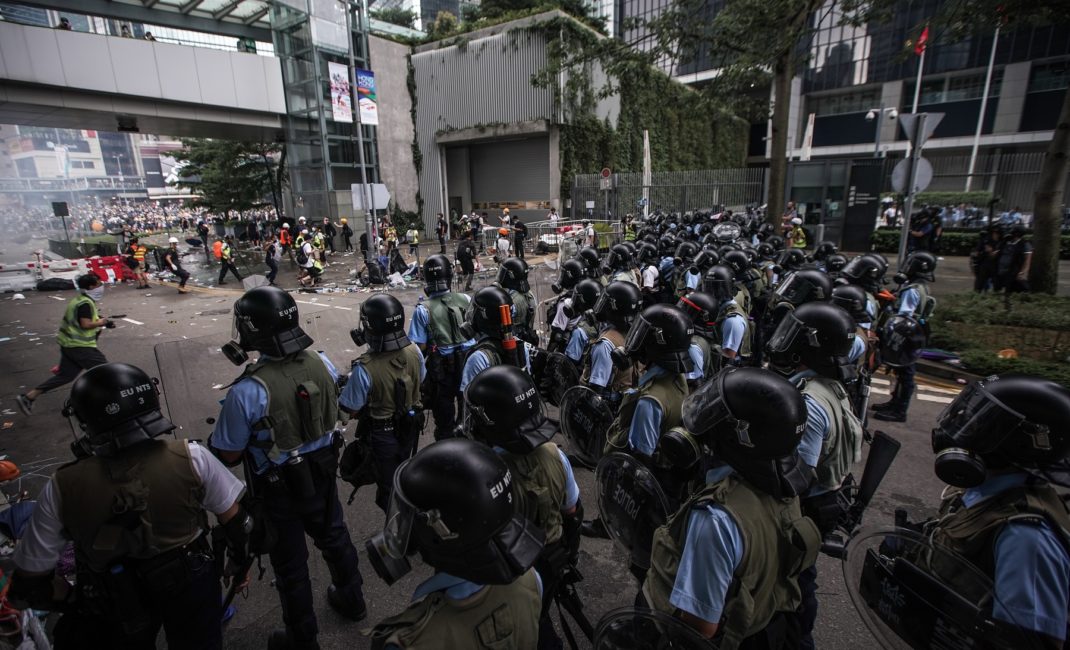
Officers gathered in protective clothing and gas masks. By Choy Fuk Sang
Not long after 3.20pm I was told that tear gas grenades were released at Tim Wa Avenue because protestors had tried to remove the crowd control barriers and confront the police, I witnessed a similar situation at my side. Some protestors were moving the barriers and people were passing industrial helmets to others. I guess they were planning to get rid of the barriers to get into the Legislative Council but their attempt failed as the place was heavily guarded by the police. And bomb! Suddenly there was this loud noise and smoke started billow. Protestors retreated and I thought the cops would only fire one or two tear gas grenades after they were widely criticised for using these weapons in the Umbrella Movement. But I was wrong.
The cops went mad—they were firing tear gas grenades repeatedly. It was a non-stop assault.
People kept retreating and fled until they reached the Harcourt Road. But that was not the end. When I arrived at Harcourt Road, smoke was also coming from places near the Citic Tower so we ran in direction of Central [the business district] but then realised that area had also been bombed with tear gas grenades at the same time. The fact is the cops were conducting a pincer movement, simultaneously attacking both sides of the protestors. And the protestors were already retreating. In no way could they have constituted a threat of any kind. Yet they attacked us anyway.
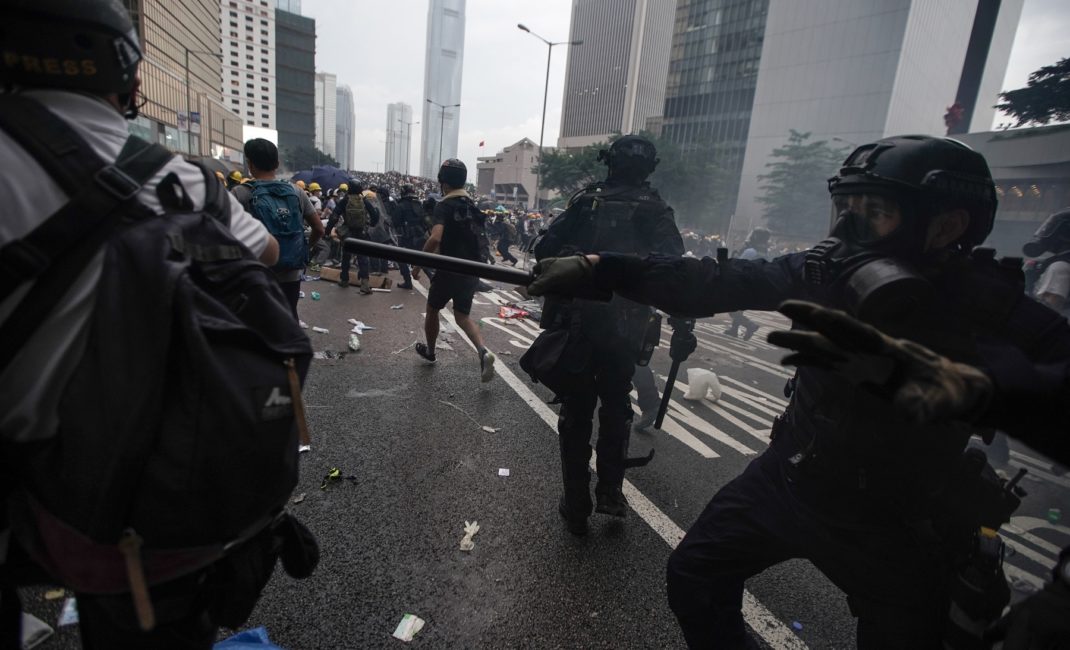
Protesters can be seen running from the tear gas as a masked officer wields a baton. By Choy Fuk Sang
The protests continue as Hongkongers call on the government to not only suspend the extradition bill but to scrap it altogether. They are rallying international attention ahead of this weekend’s G20 summit in Osaka, Japan. Hongkongers have raised more than $5 million HKD by crowdfunding and plan to publish an open letter on the front pages of 12 international newspapers, calling for the extradition bill to be on the agenda at the summit.
The letter will be signed “Hong Kong Citizens, Vanguards of Freedom.”
All images by Choy Fuk Sang.

